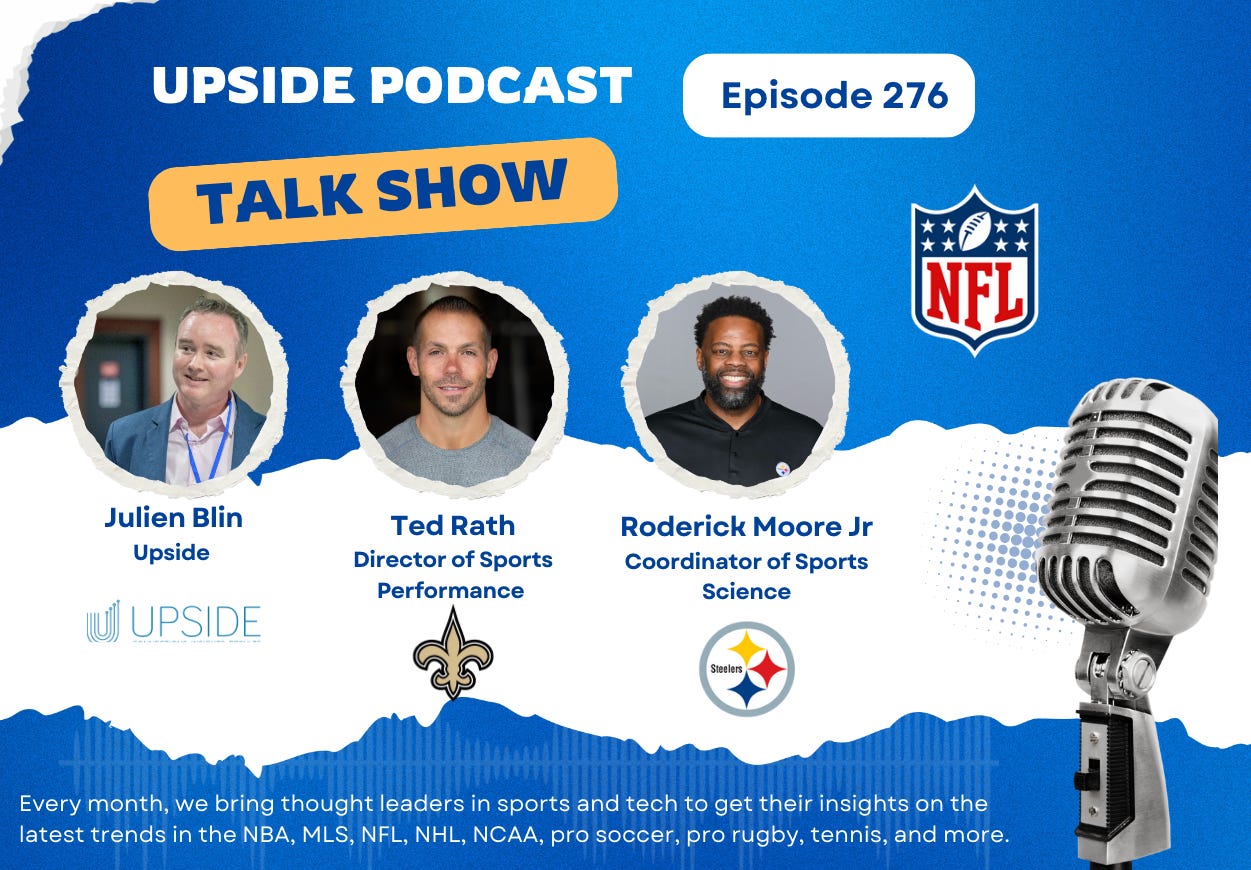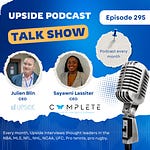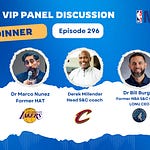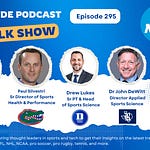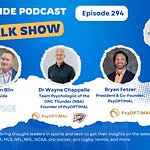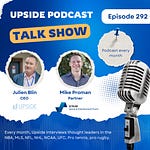This week we have the honor to interview a group of NFL sports performance executives to talk about the latest trends in the world of sports performance in the NFL.
Ted Rath, Director of sports performance, New Orleans Saints (NFL team).
Roderick Moore Jr, coordinator of sports science, Pittsburgh Steelers (NFL team).
You can watch the video interview below by clicking on the Youtube link. You can also listen to the audio interview by clicking on the link at the top of the page:
📝Show Notes: Through this interview, we touched on the best practices related to:
Team culture,
Handling adversity,
Leadership councils,
Their roles’ challenges,
Underrated technologies
You can read the full transcript of the podcast interview located at the top of this blog post.
Here are some of the best quotes of our conversation with Ted and Roderick:
Q1. Team Culture
Roderick Moore Jr:
“With culture here, especially with Coach Tomlin, he does a great job establishing it and then repeating it so consistently that it becomes ingrained. One of his favorite quotes is, ‘the standard is the standard,’ and that’s the anchor for everything we do. In the offseason, he sets expectations—how we practice, how we prepare, how we approach games. Then in camp, the same message is reinforced, and in-season it gets repeated again, but tailored toward our weekly opponents. Even last year when we started 10–3 and then lost five in a row, it didn’t feel like a losing streak because the message never changed. We addressed what needed fixing, but it was always about us versus us. If we’re not locked in on assignments and execution, the opponent doesn’t matter. That consistency—echoed not just by Coach but also by our captains and leadership group—is what carries the team through both highs and lows.”Ted Rath:
“Rod nailed it with consistency. To me, the best leaders in sports and in life have that as almost a superpower. Culture isn’t static—it’s a living, breathing organism that evolves week to week in the NFL. It’s not about what you put on a wall or graphics in the weight room—it’s about whether your actions truly match your words. The star of the team is the team, and if everyone—from the 70 players on the roster to the coaches, front office, medical and performance staff—isn’t aligned, things fall apart fast. I’ve been fortunate to see it with young head coaches like Sean McVay early on and now with Kellen Moore, and the common thread is that they keep things simple, clear, and consistent. When your captains and leadership council uphold that standard, you can literally see the culture being lived out every day.”
Q2. Handling Adversity
Ted Rath:
“Mike Tyson said it best: everybody has a plan until they get punched in the face. In the NFL, adversity is constant—it could be an injury, a fourth down you don’t convert, or a losing streak that tests everybody. What I’ve found is that when you’re losing, people become more self-critical, they look inward, they ask, ‘What can I do to fix this?’ But ironically, long winning streaks can be even more dangerous because they mask underlying problems. You can sweep issues under the rug by saying, ‘We still won.’ That’s when you have to be most self-critical and brutally honest. Every week feels like its own mini-season, and how you respond to setbacks—whether it’s with open communication or recommitting to your process—is what determines if you’re going to grow or crumble under pressure.”Roderick Moore Jr:
“Winning can cover up a lot of issues, but losing exposes everything. When you’re on a skid, it’s about being honest, identifying the root causes, and asking: are we repeating the same mistakes? Division games are a great example—you might lose to a team that knows you inside out, but when you play them again, it can’t just be about revenge. It has to be about the ‘get right’ mentality: fixing what we didn’t execute, correcting details, and making sure we’re in position to succeed. That’s how you shift the focus from being stuck in a losing streak to regaining confidence and momentum. Adversity tests everyone, but if you control what you can control, the morale and the message stay steady.”
Q3. Leadership Councils
Roderick Moore Jr:
“We rely heavily on our captains and those senior-type leaders who might not wear the title but lead by example every day. They mirror the culture we’re trying to build, and they’re the ones who make sure the message coming from Coach and staff gets lived out in the locker room. The way we do it isn’t overly formal—it’s organic and impromptu. Sometimes they meet weekly, sometimes only when an issue arises. What matters is that the communication is honest and timely. That flexibility has worked well for us because it allows leaders to step up naturally and ensures that the culture isn’t just top-down, but reinforced laterally among the players themselves.”Ted Rath:
“The leadership council is really an extension of the head coach’s voice and the culture itself. We make sure those guys are part of key conversations early on, whether it’s travel logistics—like explaining why we leave early for a West Coast game for circadian rhythm reasons—or how we structure recovery. When the council understands the ‘why,’ they communicate it to the locker room in a way that resonates. That prevents confusion and ensures buy-in. These players are the bridge for teammates who might not feel comfortable going directly to the head coach or staff. They drive the message, they live the culture, and in the best situations, they embody it so fully that you can feel the alignment across the entire building.”
Q4. Role Challenges
Roderick Moore Jr:
“People often underestimate how much of our job is about relationships and communication. You have to wear a lot of hats—psychologist, sociologist, sometimes even family counselor. These are adults with kids, spouses, pets, and lives outside of football, and those factors affect performance. Asking, ‘How’s your family doing?’ or ‘How’s your dog?’ builds trust. When athletes know you genuinely care about them as people, not just players, they open up. That bond becomes critical when things get tough. Outsiders see the weight room and practice field, but they don’t see the conversations behind the scenes that strengthen the fabric of the team.”Ted Rath:
“I’ve told young professionals coming into the field to consider a master’s in psychology because honestly, so much of what we do is people-driven. Communication is never good enough—we’re always working on it. Every issue that a player or staff member brings into your office is the most important thing in their life at that moment, and you have to give it the attention it deserves. Add to that the reality of the hours—missed birthdays, missed family time, constant travel—and it’s a sacrifice not just for you but for your family. Work-life balance doesn’t really exist; it’s an integration. But when you can build a family-oriented environment inside the facility, those moments help. At the end of the day, it’s about mind, body, and soul—helping athletes be better on the field and better human beings off it. That’s what makes a team special.”
Q5. Underrated Technologies
Roderick Moore Jr:
“A lot of teams use GPS to track mechanical load, but I think physiological load—the body’s response to that stress—is still undervalued. Heart rate monitoring, recovery markers, readiness—all of that tells you how the athlete is really responding. But it’s not just about collecting numbers; it’s about relationships and trust. Athletes are wary of data because they want to know: how will this help me, and how is it being used? If they believe it’s about career longevity and performance, they’ll buy in. But if you collect data and don’t apply it—or worse, you still have the same injuries—players notice that. The tech only matters if you use it to make sound, science-based decisions that actually improve outcomes.”Ted Rath:
“There are endless technologies we can use, but one of the most underrated tools is the subjective wellness questionnaire. It’s simple, but it provides invaluable context. Asking a player, ‘How sore are you today? How did you sleep? Where are you feeling discomfort?’ opens the door to meaningful adjustments. If a player reports soreness in his quad, maybe we change his squat pattern that day. That context drives action. And sometimes, if a player is giving the same answer every day, that’s a flag too—it tells me something deeper might be going on, whether physically or mentally. The tool isn’t about the form; it’s about the conversation it sparks. When you combine technology with trust and human connection, that’s when you really get value.”
You may also like:
🔥Upside NFL Group Chat with Ted Rath (New Orleans Saints), Roderick Moore Jr (Pittsburgh Steelers), Ryan Juarez (Washington Commanders)
This week we have the honor to interview a group of NFL sports performance executives to talk about the latest trends in the world of sports performance, load management, sleep/recovery management, rehabilitation and data & wearable tech integration, and mental performance in the NFL.


